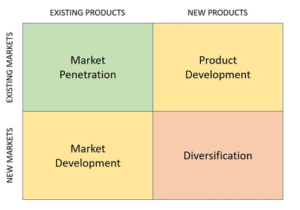Four key strategies for growth
With market dynamics changing and demand shifting, this is good time for businesses to review their position in the market. I would recommend starting this process by segmenting the market that your business currently operates in. Put another way, what products and services do you sell and to whom? Identifying the products and services is generally straight forward, but identifying the target groups can be more complex. Answering the following questions for each group of products and services might help:
- Who is making the purchase?
- Who is holding the purse strings?
- Who is making the purchase decision?
- Who is influential in that decision making process?
For B2B organisations, it is worth thinking not only about the type of business that you sell to, but also the key people within that business. For example, the procurement manager may make the purchase, but the Board may need to sign off the expenditure, individuals in different departments may be involved in product selection, and a number of third parties may be influential in specifying which products are required. It’s also worth considering that each of these groups may be motivated by different things – like product performance, certification, lead times, guarantees, payment terms, price, and so on.
Having mapped the current products and services and the existing customer base, you can explore the potential opportunities for growth. For this exercise, the Ansoff matrix below is really valuable.

In his model, Ansoff identifies four possible growth strategies for businesses:
Market penetration
Market penetration focuses on increasing sales of existing products and services to the existing market. Your market segmentation is key here, as it may well identify influential groups of people that your business is not currently targeting. Beyond that, this is about taking market share from the competition, so it’s worth understanding the strengths and weaknesses of your key competitors and putting a plan together to improve your offering and to target their customers. A good website, comprehensive digital marketing strategy and perhaps a new e-commerce platform are all good tools that help gain market share.
Product development
Product development focuses on selling new products and services to an existing market. Once again, it’s worth taking the time to review your competitors and see what they are doing well and where their weaknesses lie, both in terms of the products they offer, but also with regard to the service they offer to their customers. Address these differentials, and then go to market with a targeted campaign communicating your competitive strengths.
Another approach is to establish what other products and services your existing customers already buy from other suppliers. If you can add some of these products to your portfolio, the chances are that your existing customers will be interested.
Market development
Market development focuses on selling your existing products to new markets. Entering new overseas markets is an obvious form of market development, though it comes with its own complications (language, culture, tariffs, transport, certification etc.), so it may be better to explore market development opportunities in the UK first. It is easy for businesses to be blinkered when it comes to market development opportunities. If you have a long history of servicing one particular market segment, you may miss opportunities to sell the same products to different groups.
Not only can this be a good way to find incremental sales, broadening the customer base can also be an excellent way to spread the risk. For example, a business that is established in selling building products to contractors focussed on commercial-use buildings may be able to sell those same products to builders in the home improvement sector. Then if the demand in the commercial-use buildings market were to take a downturn, the business is still buoyed by the sales to the home improvement sector. This is especially the case if a business has a small number of large and important customers. Losing one of these customers could leave a significant hole in the business’s revenue; by winning more customer across different markets, the reliance on the few bigger customers is still there, but losing one of them is perhaps not as catastrophic as it would have been before.
Diversification
Diversification focuses on entering new markets with new products. Of the four growth strategies, this is the one that requires the most investment and carries the biggest risk. It tends to mean heading into uncharted territory, where the brand and the products are unknown to the market.
Virgin have diversified their brand amazingly well, but it’s a path that is littered with failures. Dyson broke into the vacuum cleaner market with a product that revolutionised the industry with bagless cleaning and exceptional performance. They successfully expanded their product range to include fans and hairdryers, as this is still within the home appliance space where the brand is strong and it’s not too big a shift from sucking air (vacuums) to blowing air (fans and hairdryers). Always the entrepreneur, a few years ago, Dyson invested huge sums of money in a project to develop electric cars. Despite their best efforts, this project folded in 2019. This was perhaps a stretch too far.
Diversification is absolutely worth considering, but it’s not for the faint hearted, and unless there is a compelling reason for choosing diversification, I would always recommend exploring opportunities in market penetration, product development and market development first.
Here to help
The expert team at 49Red have a wealth of experience in formulating business strategies, marketing strategies, customer segmentation, identifying growth opportunities and more. We can help you choose the right solution for your business and then deliver that solution efficiently and with no fuss. Whatever you need, we are here to help with cost-effective, no-nonsense marketing. Contact Hugh Moss on 07808 365214 or email hugh.moss@49red.co.uk to find out more.
This is the fourth of six blogs under the title ‘Five steps to post-pandemic business success’. Follow 49Red on LinkedIn or visit our website at www.49red.co.uk/news to see more.


